牛津译林版(2019)必修 第一册Unit 1 Back to school Grammar and usage 课件(共42张PPT)
文档属性
| 名称 | 牛津译林版(2019)必修 第一册Unit 1 Back to school Grammar and usage 课件(共42张PPT) | 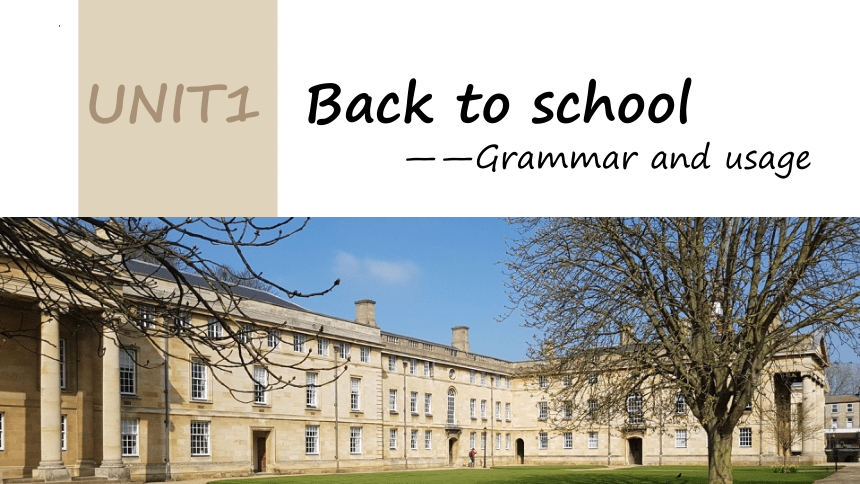 | |
| 格式 | pptx | ||
| 文件大小 | 18.0MB | ||
| 资源类型 | 教案 | ||
| 版本资源 | 牛津译林版(2019) | ||
| 科目 | 英语 | ||
| 更新时间 | 2024-07-21 19:15:09 | ||
图片预览

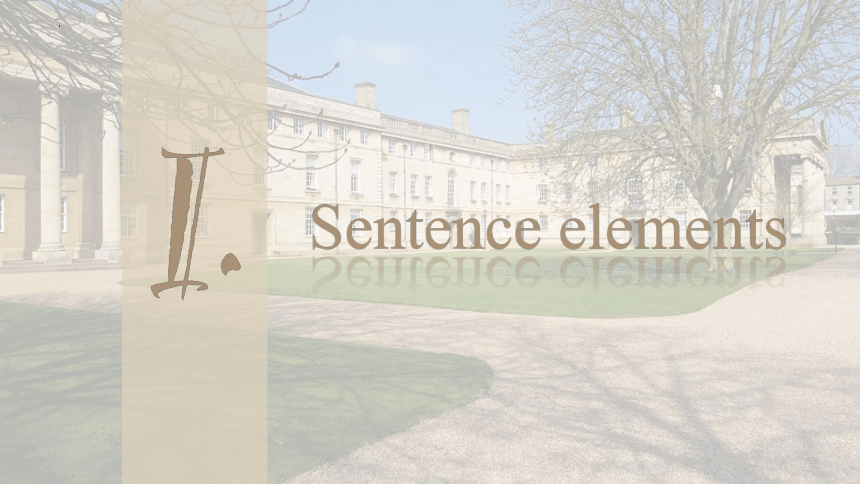

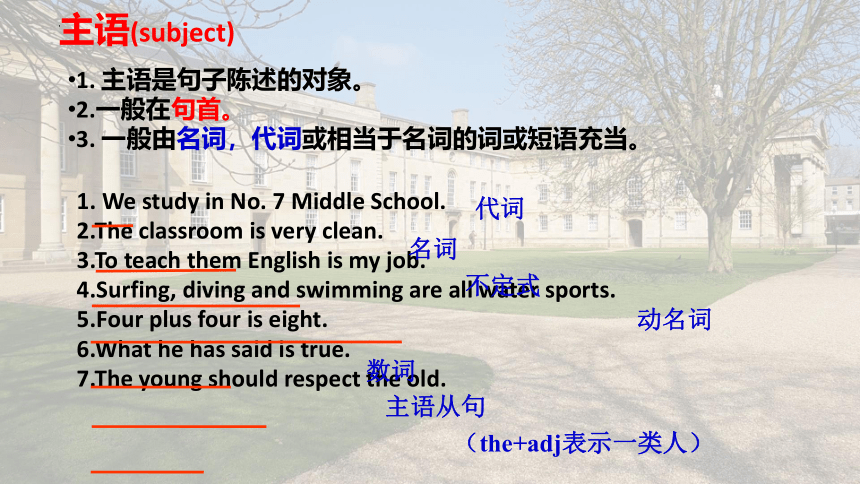
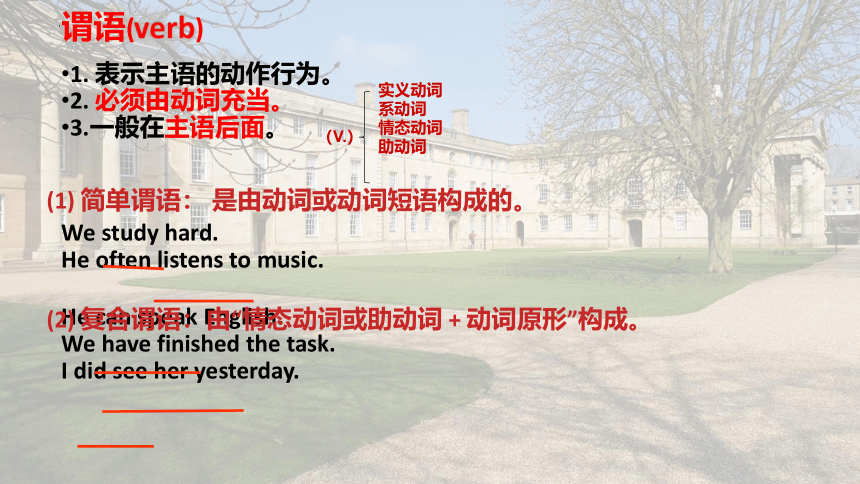
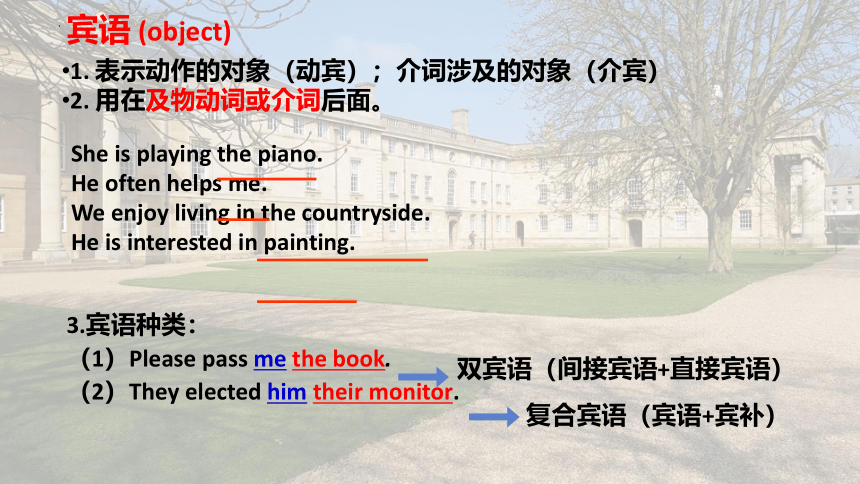
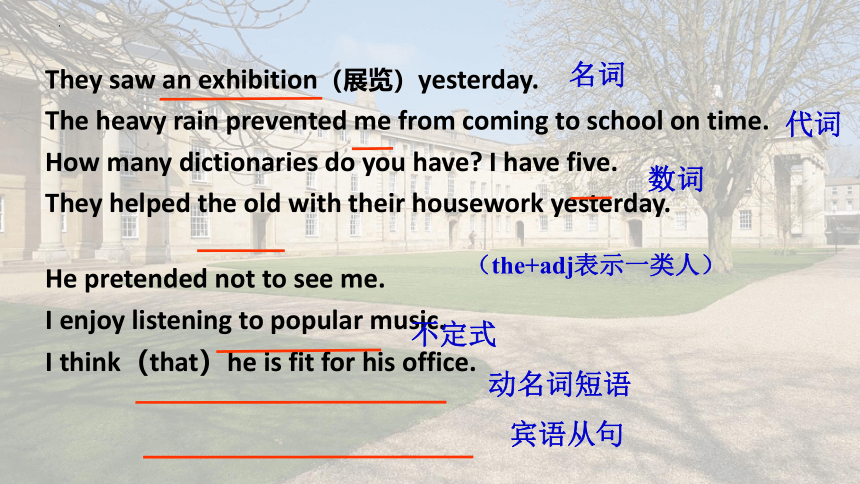
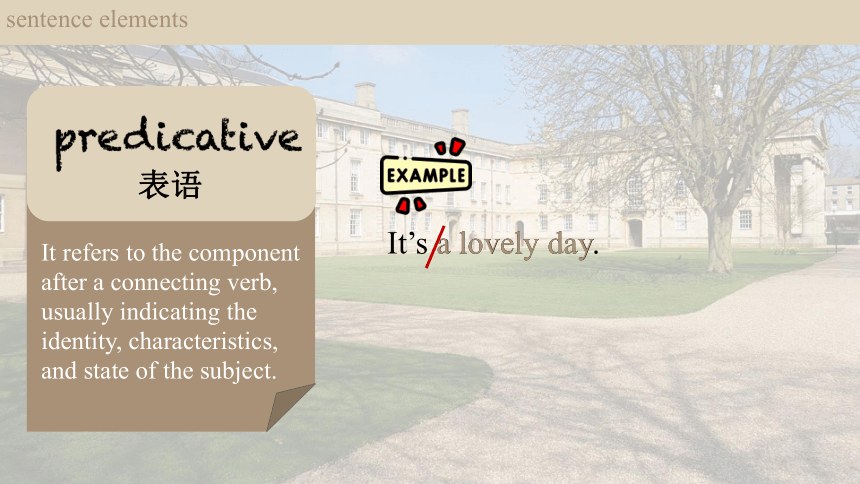
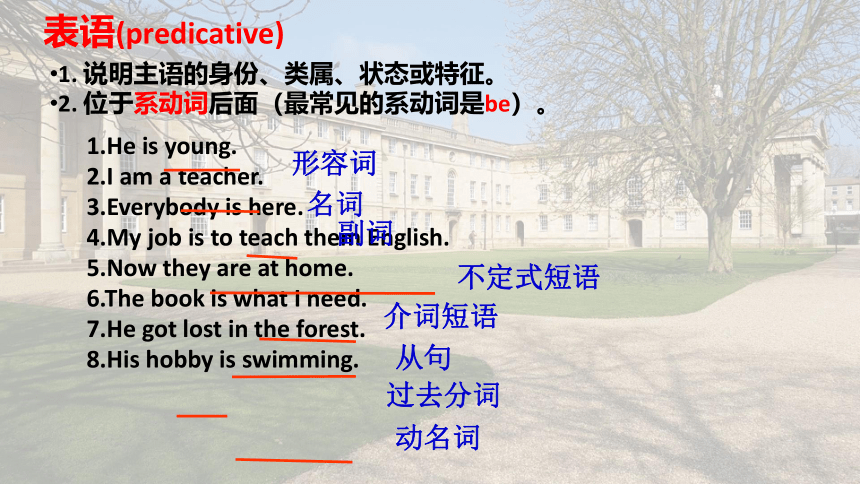
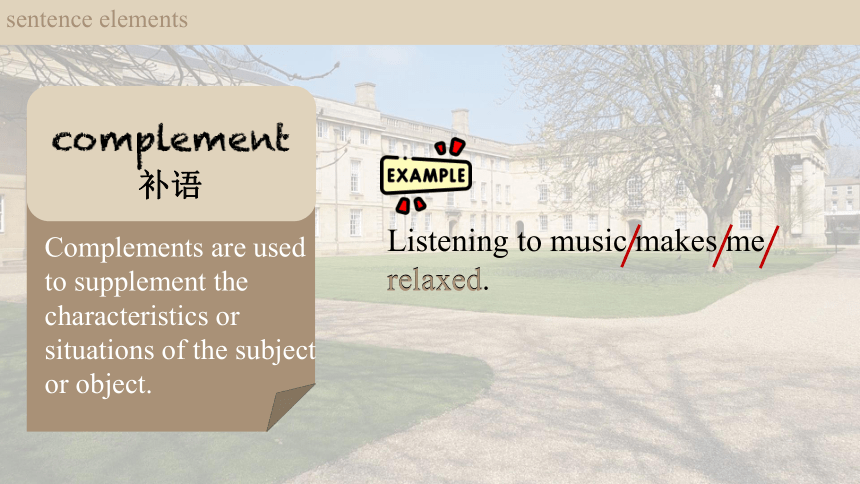
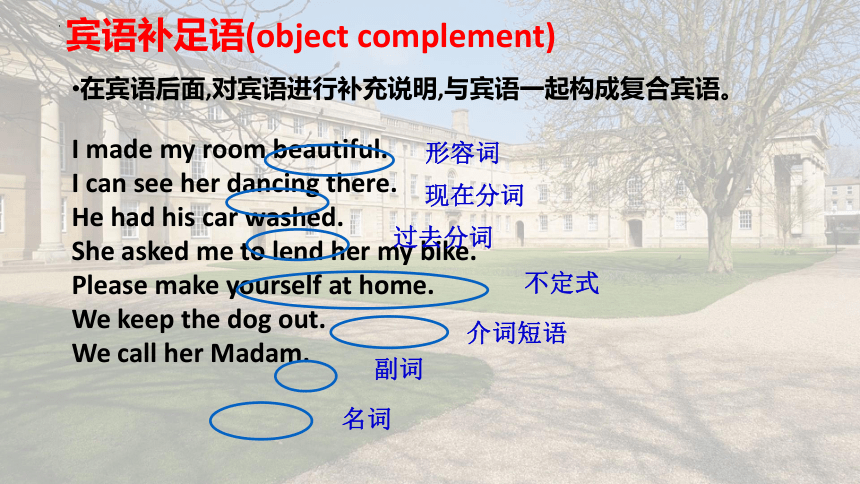
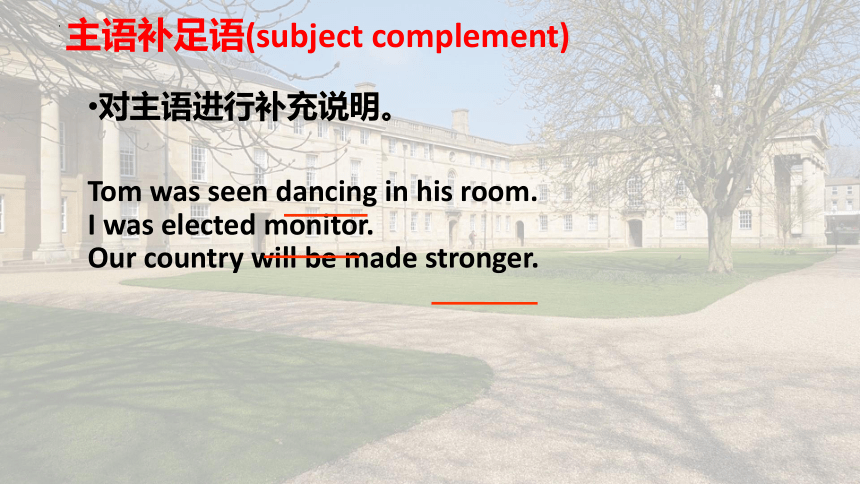
文档简介
(共42张PPT)
UNIT1 Back to school
——Grammar and usage
Sentence elements
sentence elements
It refers to the subject of the sentence.
It refers to the main verbs in the predicate part.
It refers to the object of action.
We should develop good study habits.
We
should develop
good study habits
主语(subject)
1. We study in No. 7 Middle School.
2.The classroom is very clean.
3.To teach them English is my job.
4.Surfing, diving and swimming are all water sports.
5.Four plus four is eight.
6.What he has said is true.
7.The young should respect the old.
代词
名词
不定式
动名词
数词
主语从句
(the+adj表示一类人)
1. 主语是句子陈述的对象。
2.一般在句首。
3. 一般由名词,代词或相当于名词的词或短语充当。
谓语(verb)
We study hard.
He often listens to music.
He can speak English.
We have finished the task.
I did see her yesterday.
实义动词
系动词
情态动词
助动词
(V.)
1. 表示主语的动作行为。
2. 必须由动词充当。
3.一般在主语后面。
(1) 简单谓语: 是由动词或动词短语构成的。
(2) 复合谓语:由“情态动词或助动词 + 动词原形”构成。
宾语 (object)
She is playing the piano.
He often helps me.
We enjoy living in the countryside.
He is interested in painting.
1. 表示动作的对象(动宾);介词涉及的对象(介宾)
2. 用在及物动词或介词后面。
3.宾语种类:
(1)Please pass me the book.
(2)They elected him their monitor.
双宾语(间接宾语+直接宾语)
复合宾语(宾语+宾补)
They saw an exhibition(展览)yesterday.
The heavy rain prevented me from coming to school on time.
How many dictionaries do you have I have five.
They helped the old with their housework yesterday.
He pretended not to see me.
I enjoy listening to popular music.
I think(that)he is fit for his office.
名词
代词
数词
(the+adj表示一类人)
不定式
动名词短语
宾语从句
sentence elements
It’s a lovely day.
It refers to the component after a connecting verb, usually indicating the identity, characteristics, and state of the subject.
a lovely day
表语
表语(predicative)
1.He is young.
2.I am a teacher.
3.Everybody is here.
4.My job is to teach them English.
5.Now they are at home.
6.The book is what I need.
7.He got lost in the forest.
8.His hobby is swimming.
形容词
名词
副词
不定式短语
介词短语
从句
过去分词
动名词
1. 说明主语的身份、类属、状态或特征。
2. 位于系动词后面(最常见的系动词是be)。
sentence elements
Complements are used to supplement the characteristics or situations of the subject or object.
Listening to music makes me relaxed.
relaxed
补语
宾语补足语(object complement)
I made my room beautiful.
I can see her dancing there.
He had his car washed.
She asked me to lend her my bike.
Please make yourself at home.
We keep the dog out.
We call her Madam.
形容词
现在分词
过去分词
不定式
介词短语
副词
名词
在宾语后面,对宾语进行补充说明,与宾语一起构成复合宾语。
Tom was seen dancing in his room.
I was elected monitor.
Our country will be made stronger.
主语补足语(subject complement)
对主语进行补充说明。
sentence elements
Maggie plans her study carefully.
Adverbials are used to modify verbs, adjectives, adverbs, or entire sentences
carefully
状语
状语 (adverbial)
Wait a minute.
Light travels very quickly.
I've done it hundreds of times.
I got home, tired and thirsty.
He has lived in the city for ten years.
He is proud to have passed the national college entrance examination.
They came out of the classroom, talking and laughing.
Mr Black came back drunk that night.
Once you begin, you must continue.
副词
名词
数词
形容词
介词短语
不定式短语
现在分词
过去分词
状语从句
1. 修饰动词,形容词,副词或整个句子。
2. 表示动作发生的时间,地点,原因,目的,方式,程度,结果,条件,让步,伴随等。
sentence elements
I went to a large library yesterday.
They are used to modify nouns or pronouns.
large
He doesn’t have anything to do at the moment.
to do
定语
定语(attribute) “……的”
1.He is a clever boy.
2.His father works in a shoe factory.
3.There are 54 students in our class.
4.Do you know Betty’s sister
5.His spoken English is good.
6.The girl in red is his sister.
7.I want to have something to drink.
8.The girl standing under the tree is his daughter.
9.Do you know the man who's standing there
(形容词)
(物主代词)
(数词)
(名词所有格)
(过去分词)
(介词短语)
(现在分词短语)
(从句)
(不定式)
(名词)
用来修饰名词或代词,起类似于形容词的修饰作用。
同位语(apposition)
1. Tom, our monitor, is a handsome boy.
2. I myself will do the experiment.
3. She is the oldest among them six.
4. The news that he is ill worries us.
名词
反身代词
数词
从句
1.对前面的名词或代词做进一步解释,说明它们的性质和情况。
2.在句中和前面的名词指同一人、同一物,同做一种句子成分。
3.同位语去掉后不影响句意,定语去掉后句子意思不明确。
插入语(parenthesis)
1. That will be a good beginning, I hope.
2. We'll have to take an umbrella, I' m afraid.
3. I have no money, you see.
4. He is a bad guy, you know.
5. Mr. Smith, I think, is at least 50 years old.
6. This, I suppose, will give you some idea of the situation in China.
插入语指的是对一句话所做的附加解释。其作用是,补足句意,包括说话者的态度,或引起听话者的注意。以下句子带有常见的插入语:
Sentence structures
sentence structures
Albert Einstein said, “If you want to live a happy life, tie it to a goal.”
(1) I agree. Goals are important in many ways. (2) Setting goals gives you a focus in life. By setting goals now, you are deciding what you want to achieve in the future. Then you know where you are going in life and can work hard to get there. Setting goals also helps you develop good habits. To realize your goals, you need to have a good plan, manage your time well and pay attention to details. (3) These habits will be helpful. Finally, (4) setting goals makes you more confident. When you achieve a goal, you see the result of your hard work and know how much progress you have made. A goal is a dream that needs action. As a result of your action, your dream will come true and hopefully (5) you will live a happy life.
(1) I agree.
sentence structures
(1) I agree.
I
agree
sentence structures
(3) These habits will be helpful.
These habits
will be
helpful
In English, the function of a linking verb is mainly to connect the predicate with its subject, indicating the nature, characteristics, character, or state of the subject.
linking verbs
am, is, are
was, were
being
have/has/had been
e.g. He is a teacher.
It was fantastic.
She is being kind today.
They have been poor since last year.
linking verbs
They are used to indicate that the subject continues or maintains a state or attitude.
e.g. He remains single.
This matter remains a mystery.
I always keep enthusiastic in my daily life.
Please stay calm.
linking verbs
They are used to represent the concept of “looking like”.
e.g. Do whatever seems good to you.
She didn't appear at all surprised at the news.
That book looks interesting.
linking verbs
e.g. You look sad.
It tastes sweet.
That coffee smells good.
This music sounds pleasant.
look
smell
taste
sound
feel
linking verbs
They are used to indicate a change of the subject.
e.g. The leaves of pine trees don’t turn yellow in autumn.
She fell asleep because of a day’s work.
He grew rich within a short time.
sentence structures
(5) You will live a happy life.
You
will live
a happy life
sentence structures
(2) Setting goals give you a focus in life.
Setting goals
give
a focus in life
you
sentence elements
Some verbs can be followed by two objects, usually referring to the object that represents a person as an indirect object and the object that represents a thing as a direct object.
indirect object
direct object
物直人间
sentence elements
Jack offered me some helpful advice.
me
some helpful advice
indirect object
direct object
Jack offered some helpful advice to me.
sentence elements
to
for
with
by
give
offer
send
write
…
buy
provide
book
fetch
…
provide
…
answer
deny
refuse
save
…
He gave me my luggage. He gave my luggage to me.
I wrote him a letter. I wrote a letter to him.
My mother bought me a cake. My mother bought a cake for me.
I have booked us the hotel. I have booked the hotel for.
provide sb. with sth. = provide sth. for sb.
What does the whale’s dead body provide for deep-sea animals What does the whale’s dead body provide deep-sea animals with
I answered him that question. I answered that question by him.
sentence structures
(4) Setting goals makes you more confident.
Setting goals
makes
more confident
you
The subject and the (1) _________________ are necessary parts of a sentence.
A transitive verb is always followed by a(n) (2) _________________.
Some verbs can have two objects. The indirect object usually refers to a person and the direct object a thing.
The object complement adds more information about the object.
object
object
主谓宾、定状补,主干枝叶分清楚。
主干成分主谓宾,枝叶成分定状补。
定语必居主宾前,谓前为状谓后补。
状语有时位主前,逗号分开心有数。
句子成分划分口诀
Finish B1 and try to find the rules.
Applying the Rules
B1 Mark the different elements of each sentence with different symbols.
B2. Below are some tips about setting goals. Match the underlined sentences with the correct structures. Write the letters in the boxes.
c
b
d
g
e
a
f
B3 What is your goal for the new term How are you going to achieve your goal Write about it using different sentence structures. Use the example below to help you.
I will try to improve my English in the new term. There are a lot of things I need to do achieve this goal. I will read two English novels this term. I will also try to find a language partner. Joining the English club will be helpful to me too. All my efforts will pay off!
My goal for the new term is to improve my communication skills. To achieve this goal, I will be friendlier to my classmates. Joining a school club will help me make more friends. I will also read a book on how to improve communication skills. I will succeed!
Speaking in public confidently remains a challenge to me. I find it difficult to speak in public confidently. My goal for the new term is to improve my communication skills. To achieve this goal, I will encourage myself to ask and answer more questions. Joining a club also seems a great idea. I think it can offer me a good opportunity to make new friends and acquire new skills. Besides, I will read a book on how to improve communication skills. Always try hard and I will succeed!
Sample answer
Thanks for listening!
UNIT1 Back to school
——Grammar and usage
Sentence elements
sentence elements
It refers to the subject of the sentence.
It refers to the main verbs in the predicate part.
It refers to the object of action.
We should develop good study habits.
We
should develop
good study habits
主语(subject)
1. We study in No. 7 Middle School.
2.The classroom is very clean.
3.To teach them English is my job.
4.Surfing, diving and swimming are all water sports.
5.Four plus four is eight.
6.What he has said is true.
7.The young should respect the old.
代词
名词
不定式
动名词
数词
主语从句
(the+adj表示一类人)
1. 主语是句子陈述的对象。
2.一般在句首。
3. 一般由名词,代词或相当于名词的词或短语充当。
谓语(verb)
We study hard.
He often listens to music.
He can speak English.
We have finished the task.
I did see her yesterday.
实义动词
系动词
情态动词
助动词
(V.)
1. 表示主语的动作行为。
2. 必须由动词充当。
3.一般在主语后面。
(1) 简单谓语: 是由动词或动词短语构成的。
(2) 复合谓语:由“情态动词或助动词 + 动词原形”构成。
宾语 (object)
She is playing the piano.
He often helps me.
We enjoy living in the countryside.
He is interested in painting.
1. 表示动作的对象(动宾);介词涉及的对象(介宾)
2. 用在及物动词或介词后面。
3.宾语种类:
(1)Please pass me the book.
(2)They elected him their monitor.
双宾语(间接宾语+直接宾语)
复合宾语(宾语+宾补)
They saw an exhibition(展览)yesterday.
The heavy rain prevented me from coming to school on time.
How many dictionaries do you have I have five.
They helped the old with their housework yesterday.
He pretended not to see me.
I enjoy listening to popular music.
I think(that)he is fit for his office.
名词
代词
数词
(the+adj表示一类人)
不定式
动名词短语
宾语从句
sentence elements
It’s a lovely day.
It refers to the component after a connecting verb, usually indicating the identity, characteristics, and state of the subject.
a lovely day
表语
表语(predicative)
1.He is young.
2.I am a teacher.
3.Everybody is here.
4.My job is to teach them English.
5.Now they are at home.
6.The book is what I need.
7.He got lost in the forest.
8.His hobby is swimming.
形容词
名词
副词
不定式短语
介词短语
从句
过去分词
动名词
1. 说明主语的身份、类属、状态或特征。
2. 位于系动词后面(最常见的系动词是be)。
sentence elements
Complements are used to supplement the characteristics or situations of the subject or object.
Listening to music makes me relaxed.
relaxed
补语
宾语补足语(object complement)
I made my room beautiful.
I can see her dancing there.
He had his car washed.
She asked me to lend her my bike.
Please make yourself at home.
We keep the dog out.
We call her Madam.
形容词
现在分词
过去分词
不定式
介词短语
副词
名词
在宾语后面,对宾语进行补充说明,与宾语一起构成复合宾语。
Tom was seen dancing in his room.
I was elected monitor.
Our country will be made stronger.
主语补足语(subject complement)
对主语进行补充说明。
sentence elements
Maggie plans her study carefully.
Adverbials are used to modify verbs, adjectives, adverbs, or entire sentences
carefully
状语
状语 (adverbial)
Wait a minute.
Light travels very quickly.
I've done it hundreds of times.
I got home, tired and thirsty.
He has lived in the city for ten years.
He is proud to have passed the national college entrance examination.
They came out of the classroom, talking and laughing.
Mr Black came back drunk that night.
Once you begin, you must continue.
副词
名词
数词
形容词
介词短语
不定式短语
现在分词
过去分词
状语从句
1. 修饰动词,形容词,副词或整个句子。
2. 表示动作发生的时间,地点,原因,目的,方式,程度,结果,条件,让步,伴随等。
sentence elements
I went to a large library yesterday.
They are used to modify nouns or pronouns.
large
He doesn’t have anything to do at the moment.
to do
定语
定语(attribute) “……的”
1.He is a clever boy.
2.His father works in a shoe factory.
3.There are 54 students in our class.
4.Do you know Betty’s sister
5.His spoken English is good.
6.The girl in red is his sister.
7.I want to have something to drink.
8.The girl standing under the tree is his daughter.
9.Do you know the man who's standing there
(形容词)
(物主代词)
(数词)
(名词所有格)
(过去分词)
(介词短语)
(现在分词短语)
(从句)
(不定式)
(名词)
用来修饰名词或代词,起类似于形容词的修饰作用。
同位语(apposition)
1. Tom, our monitor, is a handsome boy.
2. I myself will do the experiment.
3. She is the oldest among them six.
4. The news that he is ill worries us.
名词
反身代词
数词
从句
1.对前面的名词或代词做进一步解释,说明它们的性质和情况。
2.在句中和前面的名词指同一人、同一物,同做一种句子成分。
3.同位语去掉后不影响句意,定语去掉后句子意思不明确。
插入语(parenthesis)
1. That will be a good beginning, I hope.
2. We'll have to take an umbrella, I' m afraid.
3. I have no money, you see.
4. He is a bad guy, you know.
5. Mr. Smith, I think, is at least 50 years old.
6. This, I suppose, will give you some idea of the situation in China.
插入语指的是对一句话所做的附加解释。其作用是,补足句意,包括说话者的态度,或引起听话者的注意。以下句子带有常见的插入语:
Sentence structures
sentence structures
Albert Einstein said, “If you want to live a happy life, tie it to a goal.”
(1) I agree. Goals are important in many ways. (2) Setting goals gives you a focus in life. By setting goals now, you are deciding what you want to achieve in the future. Then you know where you are going in life and can work hard to get there. Setting goals also helps you develop good habits. To realize your goals, you need to have a good plan, manage your time well and pay attention to details. (3) These habits will be helpful. Finally, (4) setting goals makes you more confident. When you achieve a goal, you see the result of your hard work and know how much progress you have made. A goal is a dream that needs action. As a result of your action, your dream will come true and hopefully (5) you will live a happy life.
(1) I agree.
sentence structures
(1) I agree.
I
agree
sentence structures
(3) These habits will be helpful.
These habits
will be
helpful
In English, the function of a linking verb is mainly to connect the predicate with its subject, indicating the nature, characteristics, character, or state of the subject.
linking verbs
am, is, are
was, were
being
have/has/had been
e.g. He is a teacher.
It was fantastic.
She is being kind today.
They have been poor since last year.
linking verbs
They are used to indicate that the subject continues or maintains a state or attitude.
e.g. He remains single.
This matter remains a mystery.
I always keep enthusiastic in my daily life.
Please stay calm.
linking verbs
They are used to represent the concept of “looking like”.
e.g. Do whatever seems good to you.
She didn't appear at all surprised at the news.
That book looks interesting.
linking verbs
e.g. You look sad.
It tastes sweet.
That coffee smells good.
This music sounds pleasant.
look
smell
taste
sound
feel
linking verbs
They are used to indicate a change of the subject.
e.g. The leaves of pine trees don’t turn yellow in autumn.
She fell asleep because of a day’s work.
He grew rich within a short time.
sentence structures
(5) You will live a happy life.
You
will live
a happy life
sentence structures
(2) Setting goals give you a focus in life.
Setting goals
give
a focus in life
you
sentence elements
Some verbs can be followed by two objects, usually referring to the object that represents a person as an indirect object and the object that represents a thing as a direct object.
indirect object
direct object
物直人间
sentence elements
Jack offered me some helpful advice.
me
some helpful advice
indirect object
direct object
Jack offered some helpful advice to me.
sentence elements
to
for
with
by
give
offer
send
write
…
buy
provide
book
fetch
…
provide
…
answer
deny
refuse
save
…
He gave me my luggage. He gave my luggage to me.
I wrote him a letter. I wrote a letter to him.
My mother bought me a cake. My mother bought a cake for me.
I have booked us the hotel. I have booked the hotel for.
provide sb. with sth. = provide sth. for sb.
What does the whale’s dead body provide for deep-sea animals What does the whale’s dead body provide deep-sea animals with
I answered him that question. I answered that question by him.
sentence structures
(4) Setting goals makes you more confident.
Setting goals
makes
more confident
you
The subject and the (1) _________________ are necessary parts of a sentence.
A transitive verb is always followed by a(n) (2) _________________.
Some verbs can have two objects. The indirect object usually refers to a person and the direct object a thing.
The object complement adds more information about the object.
object
object
主谓宾、定状补,主干枝叶分清楚。
主干成分主谓宾,枝叶成分定状补。
定语必居主宾前,谓前为状谓后补。
状语有时位主前,逗号分开心有数。
句子成分划分口诀
Finish B1 and try to find the rules.
Applying the Rules
B1 Mark the different elements of each sentence with different symbols.
B2. Below are some tips about setting goals. Match the underlined sentences with the correct structures. Write the letters in the boxes.
c
b
d
g
e
a
f
B3 What is your goal for the new term How are you going to achieve your goal Write about it using different sentence structures. Use the example below to help you.
I will try to improve my English in the new term. There are a lot of things I need to do achieve this goal. I will read two English novels this term. I will also try to find a language partner. Joining the English club will be helpful to me too. All my efforts will pay off!
My goal for the new term is to improve my communication skills. To achieve this goal, I will be friendlier to my classmates. Joining a school club will help me make more friends. I will also read a book on how to improve communication skills. I will succeed!
Speaking in public confidently remains a challenge to me. I find it difficult to speak in public confidently. My goal for the new term is to improve my communication skills. To achieve this goal, I will encourage myself to ask and answer more questions. Joining a club also seems a great idea. I think it can offer me a good opportunity to make new friends and acquire new skills. Besides, I will read a book on how to improve communication skills. Always try hard and I will succeed!
Sample answer
Thanks for listening!
